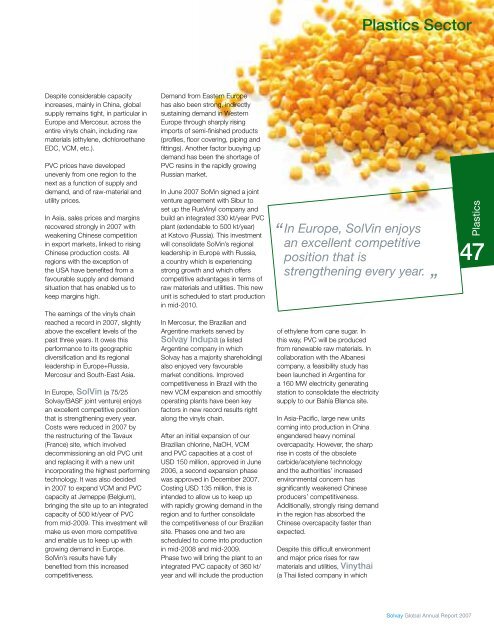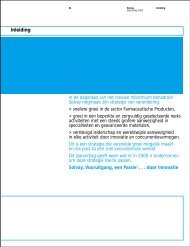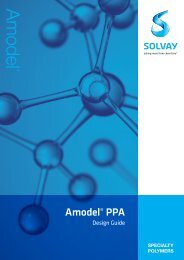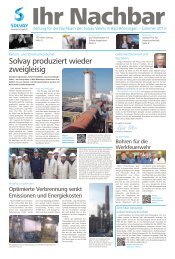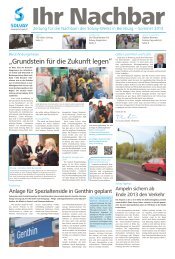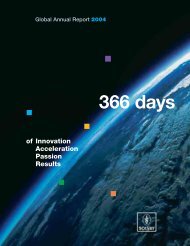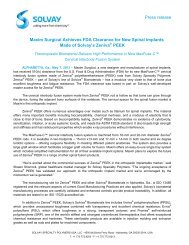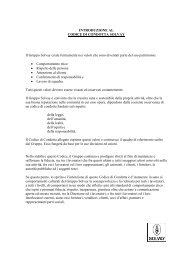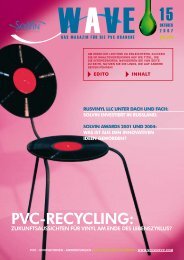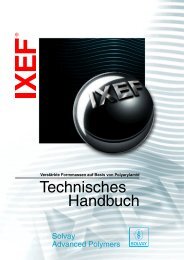+1 - Solvay
+1 - Solvay
+1 - Solvay
Create successful ePaper yourself
Turn your PDF publications into a flip-book with our unique Google optimized e-Paper software.
Plastics Sector<br />
Despite considerable capacity<br />
increases, mainly in China, global<br />
supply remains tight, in particular in<br />
Europe and Mercosur, across the<br />
entire vinyls chain, including raw<br />
materials (ethylene, dichloroethane<br />
EDC, VCM, etc.).<br />
PVC prices have developed<br />
unevenly from one region to the<br />
next as a function of supply and<br />
demand, and of raw-material and<br />
utility prices.<br />
In Asia, sales prices and margins<br />
recovered strongly in 2007 with<br />
weakening Chinese competition<br />
in export markets, linked to rising<br />
Chinese production costs. All<br />
regions with the exception of<br />
the USA have benefited from a<br />
favourable supply and demand<br />
situation that has enabled us to<br />
keep margins high.<br />
The earnings of the vinyls chain<br />
reached a record in 2007, slightly<br />
above the excellent levels of the<br />
past three years. It owes this<br />
performance to its geographic<br />
diversification and its regional<br />
leadership in Europe+Russia,<br />
Mercosur and South-East Asia.<br />
In Europe, SolVin (a 75/25<br />
<strong>Solvay</strong>/BASF joint venture) enjoys<br />
an excellent competitive position<br />
that is strengthening every year.<br />
Costs were reduced in 2007 by<br />
the restructuring of the Tavaux<br />
(France) site, which involved<br />
decommissioning an old PVC unit<br />
and replacing it with a new unit<br />
incorporating the highest performing<br />
technology. It was also decided<br />
in 2007 to expand VCM and PVC<br />
capacity at Jemeppe (Belgium),<br />
bringing the site up to an integrated<br />
capacity of 500 kt/year of PVC<br />
from mid-2009. This investment will<br />
make us even more competitive<br />
and enable us to keep up with<br />
growing demand in Europe.<br />
SolVin’s results have fully<br />
benefited from this increased<br />
competitiveness.<br />
Demand from Eastern Europe<br />
has also been strong, indirectly<br />
sustaining demand in Western<br />
Europe through sharply rising<br />
imports of semi-finished products<br />
(profiles, floor covering, piping and<br />
fittings). Another factor buoying up<br />
demand has been the shortage of<br />
PVC resins in the rapidly growing<br />
Russian market.<br />
In June 2007 SolVin signed a joint<br />
venture agreement with Sibur to<br />
set up the RusVinyl company and<br />
build an integrated 330 kt/year PVC<br />
plant (extendable to 500 kt/year)<br />
at Kstovo (Russia). This investment<br />
will consolidate SolVin’s regional<br />
leadership in Europe with Russia,<br />
a country which is experiencing<br />
strong growth and which offers<br />
competitive advantages in terms of<br />
raw materials and utilities. This new<br />
unit is scheduled to start production<br />
in mid-2010.<br />
In Mercosur, the Brazilian and<br />
Argentine markets served by<br />
<strong>Solvay</strong> Indupa (a listed<br />
Argentine company in which<br />
<strong>Solvay</strong> has a majority shareholding)<br />
also enjoyed very favourable<br />
market conditions. Improved<br />
competitiveness in Brazil with the<br />
new VCM expansion and smoothly<br />
operating plants have been key<br />
factors in new record results right<br />
along the vinyls chain.<br />
After an initial expansion of our<br />
Brazilian chlorine, NaOH, VCM<br />
and PVC capacities at a cost of<br />
USD 150 million, approved in June<br />
2006, a second expansion phase<br />
was approved in December 2007.<br />
Costing USD 135 million, this is<br />
intended to allow us to keep up<br />
with rapidly growing demand in the<br />
region and to further consolidate<br />
the competitiveness of our Brazilian<br />
site. Phases one and two are<br />
scheduled to come into production<br />
in mid-2008 and mid-2009.<br />
Phase two will bring the plant to an<br />
integrated PVC capacity of 360 kt/<br />
year and will include the production<br />
of ethylene from cane sugar. In<br />
this way, PVC will be produced<br />
from renewable raw materials. In<br />
collaboration with the Albanesi<br />
company, a feasibility study has<br />
been launched in Argentina for<br />
a 160 MW electricity generating<br />
station to consolidate the electricity<br />
supply to our Bahía Blanca site.<br />
In Asia-Pacific, large new units<br />
coming into production in China<br />
engendered heavy nominal<br />
overcapacity. However, the sharp<br />
rise in costs of the obsolete<br />
carbide/acetylene technology<br />
and the authorities’ increased<br />
environmental concern has<br />
significantly weakened Chinese<br />
producers’ competitiveness.<br />
Additionally, strongly rising demand<br />
in the region has absorbed the<br />
Chinese overcapacity faster than<br />
expected.<br />
Despite this difficult environment<br />
and major price rises for raw<br />
materials and utilities, Vinythai<br />
(a Thai listed company in which<br />
Plastics<br />
“ In Europe, SolVin enjoys<br />
an excellent competitive<br />
position that is<br />
strengthening every year.<br />
”<br />
47<br />
<strong>Solvay</strong> Global Annual Report 2007


